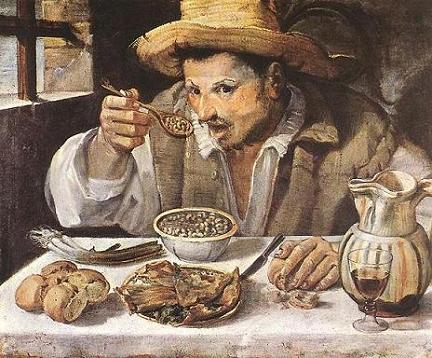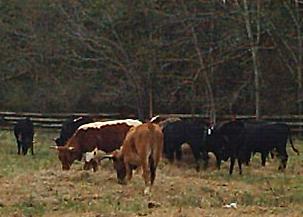Lucky Peas for a New Year
on Monday, December, 31 2013 09:55:06 pm , 1106 words
Categories: Uncategorized , 57780 views

It's rather funny sometimes the things we each notice (and others largely ignore) based upon our interests. I was recently watching Burt Wolf's Travels and Traditions (an episode on Rome) wherein he talked at one point about the Galleria Colonna and showed a famous painting therein called Mangiafagioli ("The Bean Eater"), created by the Italian Baroque painter Annibale Carracci. The painting, Wolf stressed, is known for its realism. Yet, while the importance of its style was notable, I was particularly struck by the beans the subject was depicted eating. Being a Southerner, I grew up eating black-eyed peas and thus with the folk tradition that it is especially good luck to eat them on New Year's Day. One likewise thus hears the story that black-eyed peas were brought over to the southern United States from west Africa in association with the slave trade, were fed chiefly to slaves and stock, and were long not a popular food item in the South (particularly among the wealthy) until after the War Between the States. Yet here I was viewing an image of Carracci's genre scene, oil on canvas, painted in the 1580's, which rather clearly portrays a European peasant man eating a bowl of black-eyed peas. Well, so much for the notion that black-eyed peas spread to the world from Africa by way of the American South!
One of four cultivated subspecies of cowpeas (Vigna unguiculata), black-eyed peas (Vigna unguiculata subsp. unguiculata), though popularly called "peas," are actually beans and have a long history of use--both peas, members of the genus Pisum, and beans are legumes, plants whose roots enrich the soil in which they grow by the fixation of nitrogen therein from the atmosphere. (Originally the word bean was applied mostly to broad or fava beans, but eventually was used to refer to other similar plants and their seeds, including those of the New World genus Phaseolus, as well as beans of the genus Vigna. Indeed, cowpeas and several other beans had long been lumped in to the genus classification Phaseolus.)
Black-eyed peas are believed to have first been domesticated in western Africa. Even in prehistoric times, they were cultivated in India and China. To the Romans black-eyed peas were the fagiolo all'occhio used to create the dish known as puls, offered up to the goddess Demeter, goddess of the harvest. The Babylonian Talmud (compiled from various documents over the period of the 3rd to the 5th centuries) cites the tradition of the consumption of black-eyed peas at Rosh Hashana, the Jewish New Year. For example, a rabbi Nachmani, known as Abaye ("Little Father"), of Babylonia, listed rubiyah (Arabic lubia) as a food item that brought good luck and which therefore should always be on the table at Rosh Hashana. As early as the 1730's Sephardi Jews first arrived in Georgia, where they continue to live to this day. Other early Jewish settlers arrived in New York and Charleston, South Carolina. It is believed by some that the Southern practice of consuming the beans at New Year's Day might have been influenced by the tradition of these early Jewish settlers.
Another explanation for the Southern tradition of black-eyed peas consumed for luck in the New Year has it that in the final days of the American Civil War the advancing troops of Union General William Tecumseh Sherman spared plots of field peas and field corn from pillage or destruction because such crops were considered unfit for consumption by humans.
A variant of the latter explanation is the story crediting the father of actor Rip Torn with further popularizing the consumption of black-eyed peas on New Year's Day for luck. Rip's name is actually Elmore Rual Torn, Jr.(his middle name was originally Rudolph), son of Elmore Rual and Thelma Mary (Spacek) Torn. Rip's father also was known as Rip, and the actor is a cousin of actress Sissy Spacek. But this is not a biography or a filmography of the actor, nor even much in the way of a sketch of Elmore, Sr., who was an agriculturalist and an economist. It was the senior Torn, so the story goes, who was almost entirely responsible for the current popularity throughout the American South of eating blackeyed peas for luck on New Year's Day.
Although black-eyed peas (or cowpeas) long have been eaten in the South, they were for most of that time chiefly fed to livestock and were an easily grown occasional food source for poor farmers. It was in 1909 when Athens (Henderson County), Texas, businessman J. B. Henry decided to begin growing the peas commercially. By the late 1930's and early 1940's several Athens canneries were "putting up" peas, "Home Folks" brand becoming one of the town's chief businesses, which operated until the early 1970's. For many years, this company marketed for New Year's Day a specially labeled product that it called "Good Luck Peas."
In 1947, Elmore Torn, Sr., was hired by the Henderson County Chamber of Commerce to help promote products of the area. There was little, however, to promote because of the dearth of local businesses. Besides a pottery, there was a cannery, one that canned black-eyed peas. Elmore had the local chamber print up hundreds of a flier he wrote extolling the lofty and longstanding culinary regard of the black-eyed pea. He maintained therein that in ante-bellum days rich and poor alike, even such luminaries as Jefferson Davis and Robert E. Lee, had eaten black-eyed peas on New Year's Day for good luck. Just a little before Thanksgiving, for several years, Torn sent fliers and cans of Athens, Texas, black-eyed peas to food editors throughout the South. As writer C. F. Eckhardt writes in his online article "The Great Blackeyed Pea Hoax," "Elmore started the 'tradition,' not of eating blackeyed peas per se, but the specific 'tradition' of eating blackeyed peas for good luck on New Year's Day-a 'tradition' which had never existed before 1947."
A typical Southern New Year's Day meal often consists of black-eyed peas (for good luck) and boiled ("stewed") cabbage or collard greens (for money). One of my least favorite foods is cooked dried black-eyed peas or canned black-eyed peas cooked and canned using dried peas. One of my favorites is fresh, hulled black-eyed peas (with young snaps). They are wonderful served over rice. I grow black-eyed peas almost every year. They are easy to grow and (like okra, another of my fav foods, especially dill pickled) thrive throughout the hot Texas summers, by which time other garden produce has shriveled and died.
Enjoy your black-eyed peas on New Year's Day. May you have the best of luck all year.




